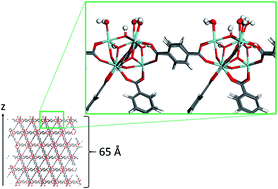当前位置:
X-MOL 学术
›
Chem. Sci.
›
论文详情
Our official English website, www.x-mol.net, welcomes your
feedback! (Note: you will need to create a separate account there.)
Understanding the origins of metal–organic framework/polymer compatibility
Chemical Science ( IF 7.6 ) Pub Date : 2017-10-27 00:00:00 , DOI: 10.1039/c7sc04152g R. Semino 1, 2, 3, 4 , J. C. Moreton 5, 6, 7, 8 , N. A. Ramsahye 1, 2, 3, 4, 9 , S. M. Cohen 5, 6, 7, 8 , G. Maurin 1, 2, 3, 4
Chemical Science ( IF 7.6 ) Pub Date : 2017-10-27 00:00:00 , DOI: 10.1039/c7sc04152g R. Semino 1, 2, 3, 4 , J. C. Moreton 5, 6, 7, 8 , N. A. Ramsahye 1, 2, 3, 4, 9 , S. M. Cohen 5, 6, 7, 8 , G. Maurin 1, 2, 3, 4
Affiliation

|
The microscopic interfacial structures for a series of metal–organic framework/polymer composites consisting of the Zr-based UiO-66 coupled with different polymers are systematically explored by applying a computational methodology that integrates density functional theory calculations and force field-based molecular dynamics simulations. These predictions are correlated with experimental findings to unravel the structure–compatibility relationship of the MOF/polymer pairs. The relative contributions of the intermolecular MOF/polymer interactions and the flexibility/rigidity of the polymer with respect to the microscopic structure of the interface are rationalized, and their impact on the compatibility of the two components in the resulting composite is discussed. The most compatible pairs among those investigated involve more flexible polymers, i.e. polyvinylidene fluoride (PVDF) and polyethylene glycol (PEG). These polymers exhibit an enhanced contact surface, due to a better adaptation of their configuration to the MOF surface. In these cases, the irregularities at the MOF surface are filled by the polymer, and even some penetration of the terminal groups of the polymer into the pores of the MOF can be observed. As a result, the affinity between the MOF and the polymer is very high; however, the pores of the MOF may be sterically blocked due to the strong MOF/polymer interactions, as evidenced by UiO-66/PEG composites. In contrast, composites involving polymers that exhibit higher rigidity, such as the polymer of intrinsic microporosity-1 (PIM-1) or polystyrene (PS), present interfacial microvoids that contribute to a decrease in the contact surface between the two components, thus reducing the MOF/polymer affinity.
中文翻译:

了解金属-有机骨架/聚合物相容性的起源
通过应用将密度泛函理论计算和基于力场的分子动力学模拟相结合的计算方法,系统地探索了由Zr基UiO-66与不同聚合物组成的一系列金属-有机骨架/聚合物复合物的微观界面结构。这些预测与实验结果相关,以揭示MOF /聚合物对的结构-相容性关系。相对于界面的微观结构,分子间MOF /聚合物相互作用和聚合物的柔韧性/刚性的相对贡献是合理的,并讨论了它们对所得复合物中两种组分的相容性的影响。在研究的那些中,最相容的对涉及更柔软的聚合物,IE聚偏二氟乙烯(PVDF)和聚乙二醇(PEG)。这些聚合物由于其构型更好地适应MOF表面而具有增强的接触表面。在这些情况下,MOF表面的不规则物被聚合物填充,甚至可以观察到聚合物的末端基团渗透到MOF的孔中。结果,MOF与聚合物之间的亲和力非常高;但是,由于MOF /聚合物之间的强相互作用,MOF的孔可能会在空间上被堵塞,如UiO-66 / PEG复合材料所证明的那样。相反,涉及具有较高刚度的聚合物(例如本征微孔率1(PIM-1)或聚苯乙烯(PS)的聚合物)的复合材料会出现界面微孔,从而降低两种组分之间的接触表面,
更新日期:2017-11-06
中文翻译:

了解金属-有机骨架/聚合物相容性的起源
通过应用将密度泛函理论计算和基于力场的分子动力学模拟相结合的计算方法,系统地探索了由Zr基UiO-66与不同聚合物组成的一系列金属-有机骨架/聚合物复合物的微观界面结构。这些预测与实验结果相关,以揭示MOF /聚合物对的结构-相容性关系。相对于界面的微观结构,分子间MOF /聚合物相互作用和聚合物的柔韧性/刚性的相对贡献是合理的,并讨论了它们对所得复合物中两种组分的相容性的影响。在研究的那些中,最相容的对涉及更柔软的聚合物,IE聚偏二氟乙烯(PVDF)和聚乙二醇(PEG)。这些聚合物由于其构型更好地适应MOF表面而具有增强的接触表面。在这些情况下,MOF表面的不规则物被聚合物填充,甚至可以观察到聚合物的末端基团渗透到MOF的孔中。结果,MOF与聚合物之间的亲和力非常高;但是,由于MOF /聚合物之间的强相互作用,MOF的孔可能会在空间上被堵塞,如UiO-66 / PEG复合材料所证明的那样。相反,涉及具有较高刚度的聚合物(例如本征微孔率1(PIM-1)或聚苯乙烯(PS)的聚合物)的复合材料会出现界面微孔,从而降低两种组分之间的接触表面,











































 京公网安备 11010802027423号
京公网安备 11010802027423号